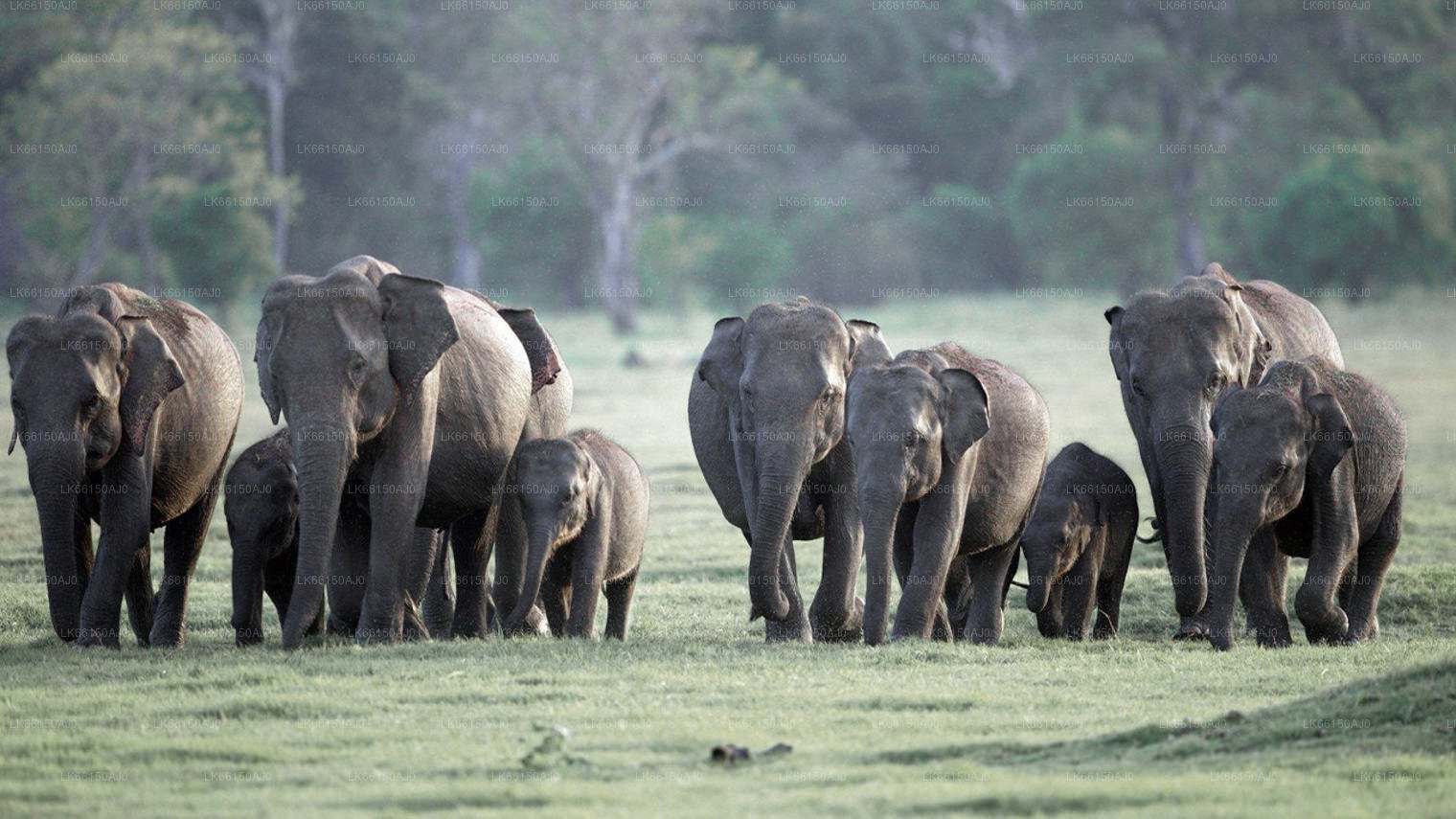
Ciudad de Minneriya
Minneriya, ubicada en Sri Lanka, es famosa por su Parque Nacional, un punto clave de biodiversidad y hogar de una gran población de elefantes asiáticos. El punto focal del parque es el pintoresco Tanque de Minneriya, que atrae a los amantes de la vida silvestre y ofrece un escenario espectacular para safaris naturales.
Parque Nacional de Minneriya
Minneriya National Park is located 182 km away from Colombo in the North Central Plains of Sri Lanka. The major city closest to Minneriya National Park is Polonnaruwa.
The renovated vast ancient Minneriya Rainwater Reservoir that irrigates the considerable area of the district of Polonnaruwa is the focal point of the Minneriya National Park.
Being part of the elephant corridor which joins up with Kaudulla and Wasgomuwa parks, Minneriya National Park gives the opportunity to see herds of Elephants throughout the year. May to October is the best period to visit Minneriya National Park in view of the famous Gathering of the wild elephants.
The Climate and Altitude
Minneriya National Park that covers an area of 8,889 hectares is of tropical monsoon climate: annual rainfall is about 1146mm and mean annual temperature is 27.5 centigrade. The altitude ranges from100m to 885m at the top of Nilgala peak.
Accommodation Options
Minneriya National Park has no accommodation facilities within its boundaries. But the cities close to Minneriya National Park-Sigiriya, Polonnaruwa, Habrana and Giritale- are clustered with luxury hotels and lodges.
Vegetation
The vegetation of the park consists of tropical dry mixed evergreen forests, abandoned chena lands, grasslands and wetlands. The open grasslands and old chena lands are dominated by the many species of small shrub.
The abandoned chenas are dominated by kukuruman (Randia dumetorum), keppettia (Croton sp.) wara (Calotropis Gigantea) and grasses i.e. katu-una (Bambusa bambos), wali indi (Phonenix zeylanica), illuk (Imerata Cylindirca) and pohon (Panicum Maximum).
The phytoplankton is dominated by Microcystis and Melosira.Among the large trees are palu (Manilkara Hexandra), Satin (Chloroxylon Swietenia), milla (Vitex Altissima), Kalumediriya (Diospyros Quaesita), halmilla (Berrya Cordifolia), weera (Drypets Sepiaria).
Mammals
Among the 24 species of mammals resident in the park are Elephants, Leopards, Sloth Bear, Spotted Deer, Sambar Deer, Wild Buffalo, Wild Pig, Grey Langers, Purple-faced Leaf Monkey, three species of Mongoose, Porcupine and Indian Pangolin. Pre-booked Minneriya Safari is the best way to see them all.
Amphibians & Reptiles
Among the nine species of Amphibians at Minneriya National Park are the endemic and endangered Slender Wood Frog and the Common Tree Frog. Of the 25 species of reptiles recorded in the park 8 are endemic including the Red-lipped Lizard. Water and Land Monitors are also seen here. The Mugger Crocodile can be seen near the tank. Many species of fresh water fish are found in the Minneriya reservoir.
Important Info:
Elephant Migration between Minneriya, Kaudulla and Hurulu Eco Park
There are three national parks in the close proximity within that region. They are the Minneriya National Park, the Kaudulla National Park, and the Hurulu Eco Park,. All of the three parks are immensely popular among locals and foreigners the world over for their large herds of elephants. Generally, each year during the months of July to September large groups of elephants are found in the Minneriya National Park and then they migrate to Kaudulla National Park during the months October to November due to high rains and lakes getting filled up. Then the elephants move on to Hurulu Eco Park for the final leg of their migration during the month of December to January.
Resources
Biodiversity Baseline Survey: Minneriya National Park
Other National Parks
Yala National Park, Udawalawe National Park, Minneriya National Park, Wilpattu National Park, Wasgamuwa National Park, Kumana National Park, Bundala National Park, Kaudulla National Park, Gal Oya National Park, Kalawewa National Park, Lunugamvehera National Park, Pigeon Island National Park, Hurulu Eco Park, Lahugala Kitulana National Park, Maduru Oya National Park
Acerca del distrito de Polonnaruwa
Polonnaruwa es la segunda ciudad más grande de la provincia centro-norte de Sri Lanka. La antigua ciudad de Polonnaruwa ha sido declarada Patrimonio de la Humanidad por la UNESCO. Polonnaruwa cuenta con una larga historia de conquista y lucha, y con razón constituye el tercer elemento del Triángulo Cultural. Ubicada a unos 140 km al noreste de Kandy, Polonnaruwa ofrece horas de inagotable placer para los amantes de la historia y la cultura, gracias a sus numerosos lugares de interés.
Gran parte de las ruinas que aún se conservan se atribuyen al rey Parakrama Bahu I, quien invirtió importantes recursos reales en la planificación urbana, incluyendo parques, edificios, sistemas de riego, etc. Su reinado se considera una época dorada, donde el reino prosperó bajo un gobernante visionario. El Parakrama Samudra es un tanque gigantesco que lleva el nombre de su patrón. El popular Palacio Real del rey, la Sala de Audiencias, rodeada de elefantes de piedra bellamente tallados, y la Piscina de Baño reflejan la superior capacidad de ingeniería de la época.
Acerca de la Provincia Central del Norte
La Provincia Central del Norte, la más grande del país, abarca el 16% de la superficie total del país. Está compuesta por dos distritos: Polonnaruwa y Anuradhapure. Anuradhapura es el distrito más grande de Sri Lanka, con una superficie de 7128 km².
La Provincia Central del Norte ofrece un gran potencial para que los inversores inicien sus negocios, especialmente en los sectores agrícola, agroindustrial y ganadero. Más del 65% de la población de la Provincia Central del Norte depende de la agricultura y las industrias agropecuarias. El NCP también se conoce como "Wew Bendi Rajje" debido a sus más de 3000 tanques de mediano y gran tamaño. Sri Maha Bodiya, Ruwanweli Seya, Thuparama Dageba, el Monasterio de Abayagiri, Polonnaruwa Rankot Wehera y Lankathilake son algunos de los lugares más emblemáticos de la Provincia Central del Norte.








